Reflective Practice on Health and Safety
VerifiedAdded on 2020/02/12
|16
|5245
|41
AI Summary
This assignment focuses on applying the Gibbs reflective cycle to analyze a health and safety scenario within a health and social care context. Students are tasked with reflecting on a specific situation, identifying key elements, and outlining lessons learned for future practice. The assignment emphasizes the importance of critical thinking and self-awareness in ensuring safe and effective patient care.
Contribute Materials
Your contribution can guide someone’s learning journey. Share your
documents today.

Health and Safety in Health
and Social Care
and Social Care
Secure Best Marks with AI Grader
Need help grading? Try our AI Grader for instant feedback on your assignments.
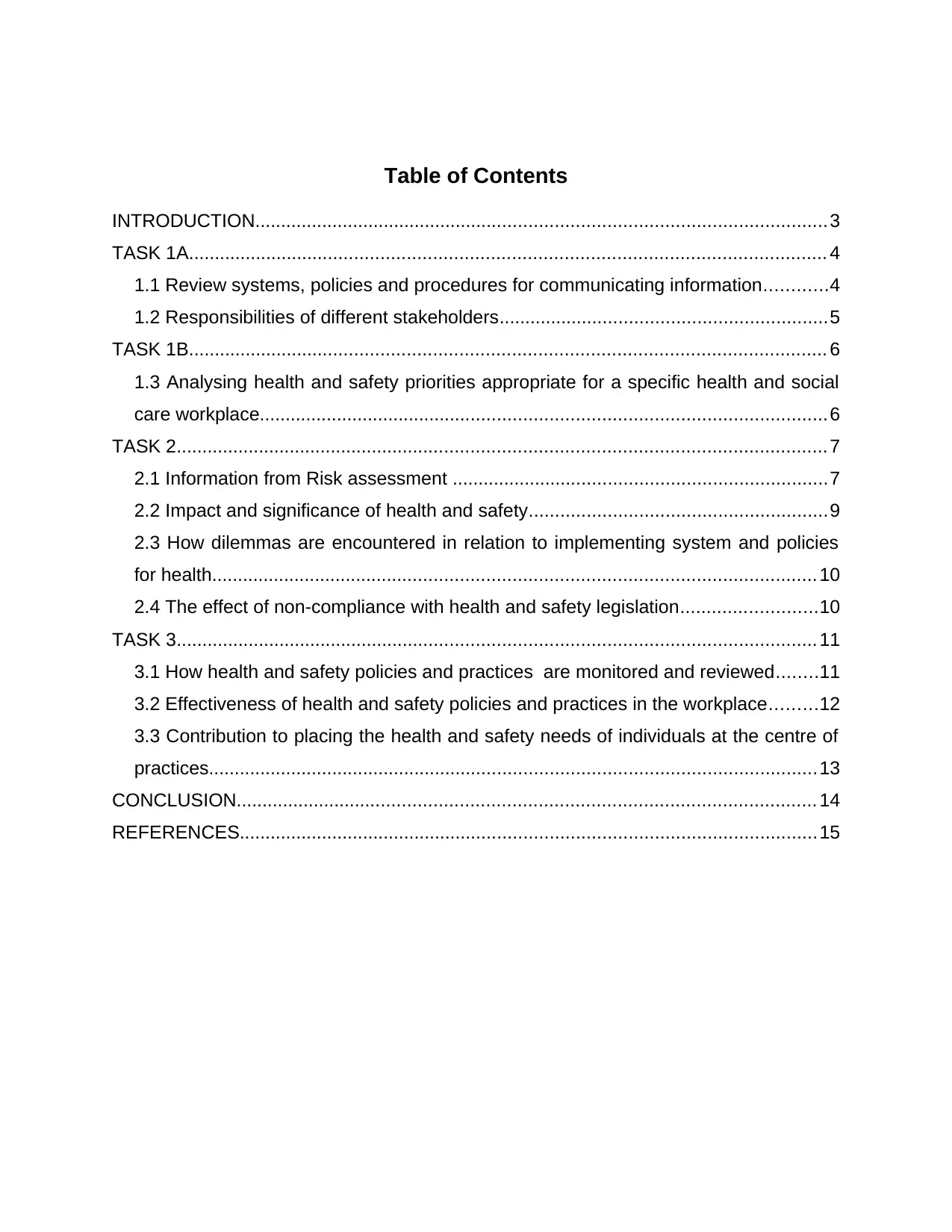
Table of Contents
INTRODUCTION..............................................................................................................3
TASK 1A.......................................................................................................................... 4
1.1 Review systems, policies and procedures for communicating information............4
1.2 Responsibilities of different stakeholders...............................................................5
TASK 1B.......................................................................................................................... 6
1.3 Analysing health and safety priorities appropriate for a specific health and social
care workplace.............................................................................................................6
TASK 2.............................................................................................................................7
2.1 Information from Risk assessment ........................................................................7
2.2 Impact and significance of health and safety.........................................................9
2.3 How dilemmas are encountered in relation to implementing system and policies
for health.................................................................................................................... 10
2.4 The effect of non-compliance with health and safety legislation..........................10
TASK 3........................................................................................................................... 11
3.1 How health and safety policies and practices are monitored and reviewed........11
3.2 Effectiveness of health and safety policies and practices in the workplace.........12
3.3 Contribution to placing the health and safety needs of individuals at the centre of
practices.....................................................................................................................13
CONCLUSION............................................................................................................... 14
REFERENCES...............................................................................................................15
INTRODUCTION..............................................................................................................3
TASK 1A.......................................................................................................................... 4
1.1 Review systems, policies and procedures for communicating information............4
1.2 Responsibilities of different stakeholders...............................................................5
TASK 1B.......................................................................................................................... 6
1.3 Analysing health and safety priorities appropriate for a specific health and social
care workplace.............................................................................................................6
TASK 2.............................................................................................................................7
2.1 Information from Risk assessment ........................................................................7
2.2 Impact and significance of health and safety.........................................................9
2.3 How dilemmas are encountered in relation to implementing system and policies
for health.................................................................................................................... 10
2.4 The effect of non-compliance with health and safety legislation..........................10
TASK 3........................................................................................................................... 11
3.1 How health and safety policies and practices are monitored and reviewed........11
3.2 Effectiveness of health and safety policies and practices in the workplace.........12
3.3 Contribution to placing the health and safety needs of individuals at the centre of
practices.....................................................................................................................13
CONCLUSION............................................................................................................... 14
REFERENCES...............................................................................................................15
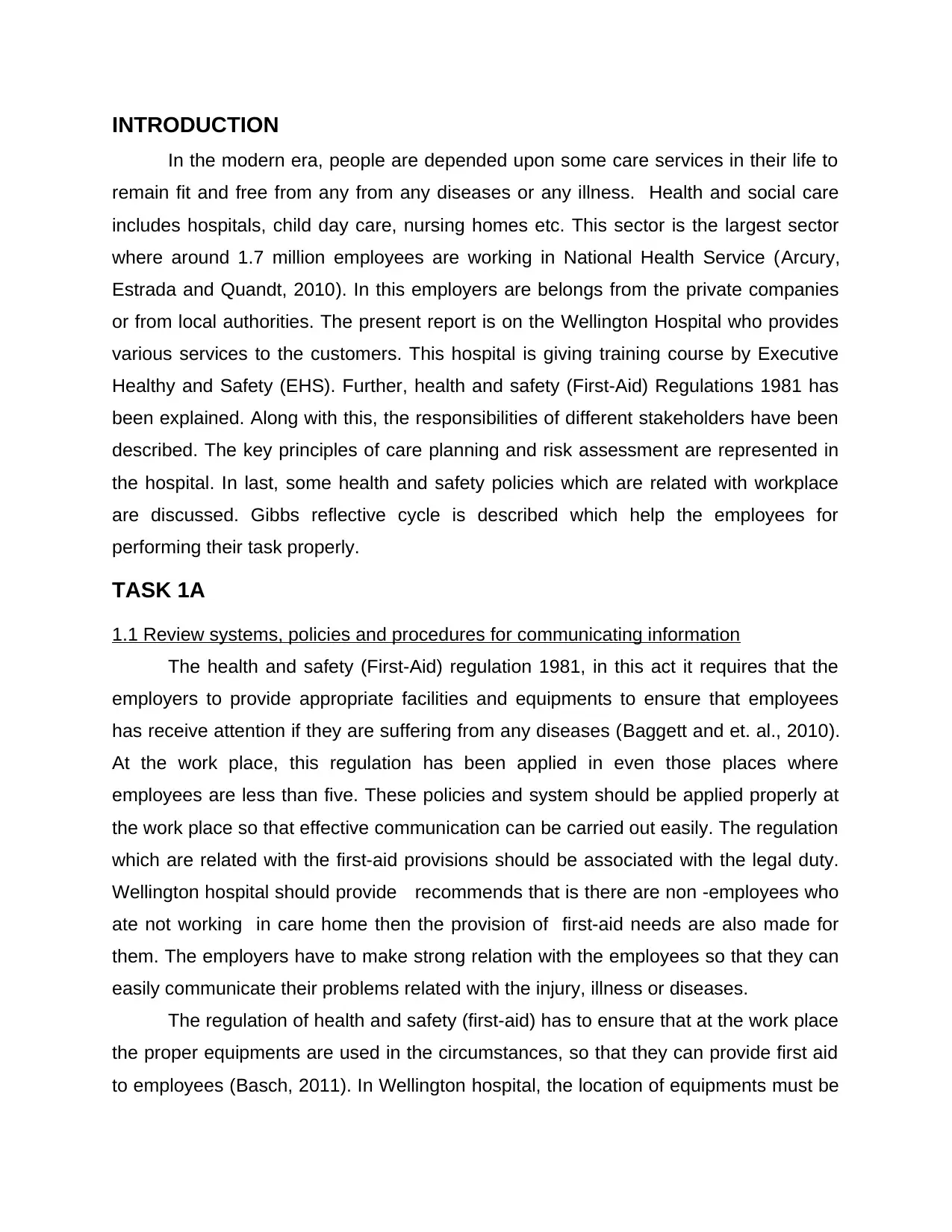
INTRODUCTION
In the modern era, people are depended upon some care services in their life to
remain fit and free from any from any diseases or any illness. Health and social care
includes hospitals, child day care, nursing homes etc. This sector is the largest sector
where around 1.7 million employees are working in National Health Service (Arcury,
Estrada and Quandt, 2010). In this employers are belongs from the private companies
or from local authorities. The present report is on the Wellington Hospital who provides
various services to the customers. This hospital is giving training course by Executive
Healthy and Safety (EHS). Further, health and safety (First-Aid) Regulations 1981 has
been explained. Along with this, the responsibilities of different stakeholders have been
described. The key principles of care planning and risk assessment are represented in
the hospital. In last, some health and safety policies which are related with workplace
are discussed. Gibbs reflective cycle is described which help the employees for
performing their task properly.
TASK 1A
1.1 Review systems, policies and procedures for communicating information
The health and safety (First-Aid) regulation 1981, in this act it requires that the
employers to provide appropriate facilities and equipments to ensure that employees
has receive attention if they are suffering from any diseases (Baggett and et. al., 2010).
At the work place, this regulation has been applied in even those places where
employees are less than five. These policies and system should be applied properly at
the work place so that effective communication can be carried out easily. The regulation
which are related with the first-aid provisions should be associated with the legal duty.
Wellington hospital should provide recommends that is there are non -employees who
ate not working in care home then the provision of first-aid needs are also made for
them. The employers have to make strong relation with the employees so that they can
easily communicate their problems related with the injury, illness or diseases.
The regulation of health and safety (first-aid) has to ensure that at the work place
the proper equipments are used in the circumstances, so that they can provide first aid
to employees (Basch, 2011). In Wellington hospital, the location of equipments must be
In the modern era, people are depended upon some care services in their life to
remain fit and free from any from any diseases or any illness. Health and social care
includes hospitals, child day care, nursing homes etc. This sector is the largest sector
where around 1.7 million employees are working in National Health Service (Arcury,
Estrada and Quandt, 2010). In this employers are belongs from the private companies
or from local authorities. The present report is on the Wellington Hospital who provides
various services to the customers. This hospital is giving training course by Executive
Healthy and Safety (EHS). Further, health and safety (First-Aid) Regulations 1981 has
been explained. Along with this, the responsibilities of different stakeholders have been
described. The key principles of care planning and risk assessment are represented in
the hospital. In last, some health and safety policies which are related with workplace
are discussed. Gibbs reflective cycle is described which help the employees for
performing their task properly.
TASK 1A
1.1 Review systems, policies and procedures for communicating information
The health and safety (First-Aid) regulation 1981, in this act it requires that the
employers to provide appropriate facilities and equipments to ensure that employees
has receive attention if they are suffering from any diseases (Baggett and et. al., 2010).
At the work place, this regulation has been applied in even those places where
employees are less than five. These policies and system should be applied properly at
the work place so that effective communication can be carried out easily. The regulation
which are related with the first-aid provisions should be associated with the legal duty.
Wellington hospital should provide recommends that is there are non -employees who
ate not working in care home then the provision of first-aid needs are also made for
them. The employers have to make strong relation with the employees so that they can
easily communicate their problems related with the injury, illness or diseases.
The regulation of health and safety (first-aid) has to ensure that at the work place
the proper equipments are used in the circumstances, so that they can provide first aid
to employees (Basch, 2011). In Wellington hospital, the location of equipments must be

used in a proper manner so that it will not cause any obstacles for employees. The
employers have to provide proper information to employees regarding the first aid.
Those workers who are new in the organisation the proper training training should be
provided in respect of information which are related with the health and social care rules
and regulations (Berwick and Finkelstein, 2010). At the workplace, the assessment
regarding hazards and risks are established at the appropriate level in of the provisions
of first-aid. Those activities which are done at home are involve low risk and therefore
these person require less first-aid provision equipments. But at the workplace, the first-
aid equipments should be provided in a better way. This regulation requires that the
person, they have to control to provide the suitable medical and first-aid facilities which
should be given by trained employees.
This Act provides basic guidance to manage the provision of first-aid, make the
employees aware about the first-aid arrangement. There are many methods on
communication which can be applied by the employers such as intranet bulletin board,
emails, formal training, face-to-face communication etc.
1.2 Responsibilities of different stakeholders
In Wellington hospital, there are different stakeholders such as employer,
employees, visitors, customers, and partners (Bradley and et. al., 2011). The
responsibilities of these stakeholders are specified in legislation and help the
organisation in promoting effective health and safety practices at the workplace.
The responsibilities of different stakeholders are described as below.
Employers – Under the health and safety at work act 1974, the first
responsibility of the employer is to provide safety and healthy environment to
employees at the work place. In Wellington hospital, the employers responsibilities also
include safe equipment, plant and machinery should be used to carry out the risk
assessment which are made in the regulations and take the necessary steps to
eliminate these risk (Braveman, Egerter and Williams, 2011). these information
regarding the potential hazards which are associated with work place should be given
properly to workers and provide adequate facilities to staff for their welfares at the
workplace.
employers have to provide proper information to employees regarding the first aid.
Those workers who are new in the organisation the proper training training should be
provided in respect of information which are related with the health and social care rules
and regulations (Berwick and Finkelstein, 2010). At the workplace, the assessment
regarding hazards and risks are established at the appropriate level in of the provisions
of first-aid. Those activities which are done at home are involve low risk and therefore
these person require less first-aid provision equipments. But at the workplace, the first-
aid equipments should be provided in a better way. This regulation requires that the
person, they have to control to provide the suitable medical and first-aid facilities which
should be given by trained employees.
This Act provides basic guidance to manage the provision of first-aid, make the
employees aware about the first-aid arrangement. There are many methods on
communication which can be applied by the employers such as intranet bulletin board,
emails, formal training, face-to-face communication etc.
1.2 Responsibilities of different stakeholders
In Wellington hospital, there are different stakeholders such as employer,
employees, visitors, customers, and partners (Bradley and et. al., 2011). The
responsibilities of these stakeholders are specified in legislation and help the
organisation in promoting effective health and safety practices at the workplace.
The responsibilities of different stakeholders are described as below.
Employers – Under the health and safety at work act 1974, the first
responsibility of the employer is to provide safety and healthy environment to
employees at the work place. In Wellington hospital, the employers responsibilities also
include safe equipment, plant and machinery should be used to carry out the risk
assessment which are made in the regulations and take the necessary steps to
eliminate these risk (Braveman, Egerter and Williams, 2011). these information
regarding the potential hazards which are associated with work place should be given
properly to workers and provide adequate facilities to staff for their welfares at the
workplace.
Secure Best Marks with AI Grader
Need help grading? Try our AI Grader for instant feedback on your assignments.
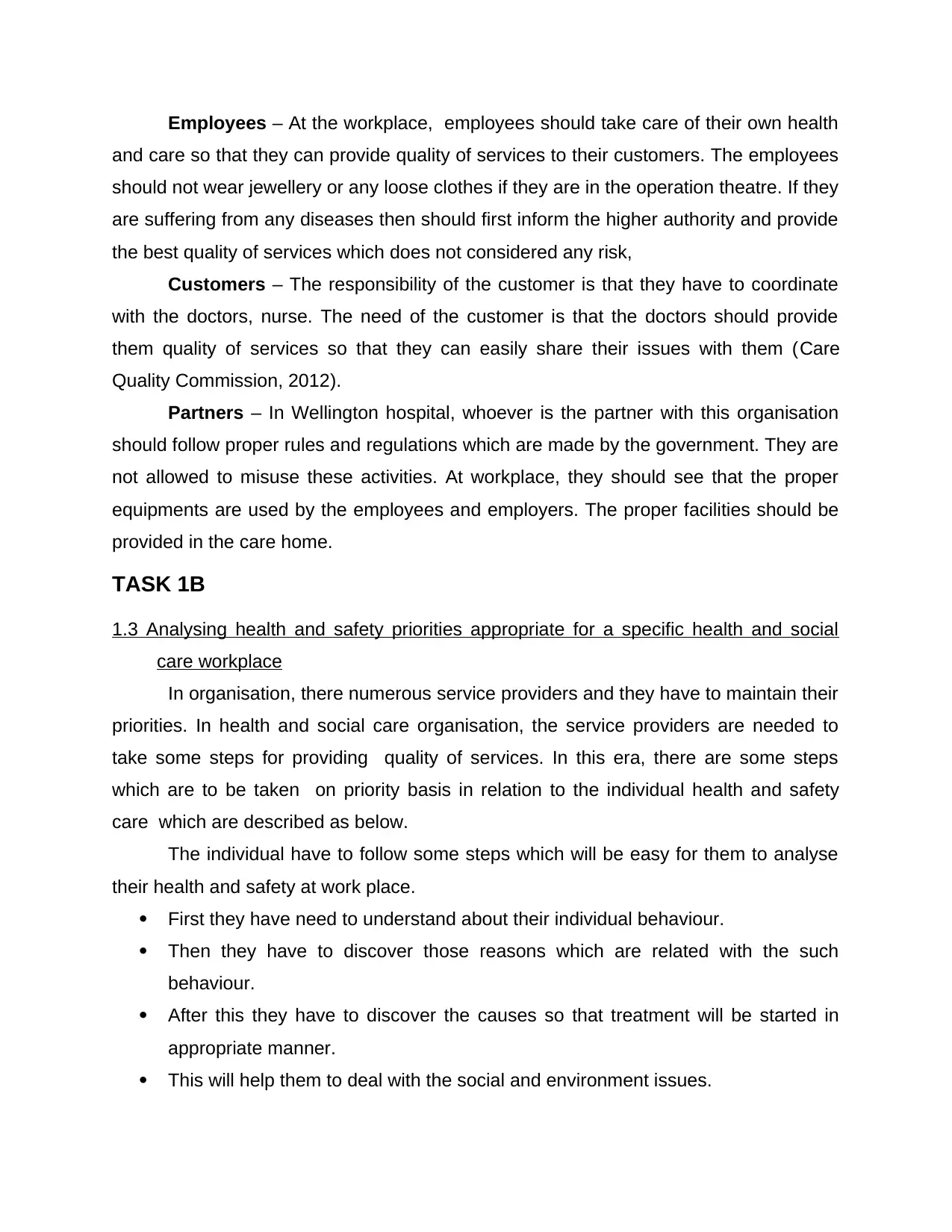
Employees – At the workplace, employees should take care of their own health
and care so that they can provide quality of services to their customers. The employees
should not wear jewellery or any loose clothes if they are in the operation theatre. If they
are suffering from any diseases then should first inform the higher authority and provide
the best quality of services which does not considered any risk,
Customers – The responsibility of the customer is that they have to coordinate
with the doctors, nurse. The need of the customer is that the doctors should provide
them quality of services so that they can easily share their issues with them (Care
Quality Commission, 2012).
Partners – In Wellington hospital, whoever is the partner with this organisation
should follow proper rules and regulations which are made by the government. They are
not allowed to misuse these activities. At workplace, they should see that the proper
equipments are used by the employees and employers. The proper facilities should be
provided in the care home.
TASK 1B
1.3 Analysing health and safety priorities appropriate for a specific health and social
care workplace
In organisation, there numerous service providers and they have to maintain their
priorities. In health and social care organisation, the service providers are needed to
take some steps for providing quality of services. In this era, there are some steps
which are to be taken on priority basis in relation to the individual health and safety
care which are described as below.
The individual have to follow some steps which will be easy for them to analyse
their health and safety at work place.
First they have need to understand about their individual behaviour.
Then they have to discover those reasons which are related with the such
behaviour.
After this they have to discover the causes so that treatment will be started in
appropriate manner.
This will help them to deal with the social and environment issues.
and care so that they can provide quality of services to their customers. The employees
should not wear jewellery or any loose clothes if they are in the operation theatre. If they
are suffering from any diseases then should first inform the higher authority and provide
the best quality of services which does not considered any risk,
Customers – The responsibility of the customer is that they have to coordinate
with the doctors, nurse. The need of the customer is that the doctors should provide
them quality of services so that they can easily share their issues with them (Care
Quality Commission, 2012).
Partners – In Wellington hospital, whoever is the partner with this organisation
should follow proper rules and regulations which are made by the government. They are
not allowed to misuse these activities. At workplace, they should see that the proper
equipments are used by the employees and employers. The proper facilities should be
provided in the care home.
TASK 1B
1.3 Analysing health and safety priorities appropriate for a specific health and social
care workplace
In organisation, there numerous service providers and they have to maintain their
priorities. In health and social care organisation, the service providers are needed to
take some steps for providing quality of services. In this era, there are some steps
which are to be taken on priority basis in relation to the individual health and safety
care which are described as below.
The individual have to follow some steps which will be easy for them to analyse
their health and safety at work place.
First they have need to understand about their individual behaviour.
Then they have to discover those reasons which are related with the such
behaviour.
After this they have to discover the causes so that treatment will be started in
appropriate manner.
This will help them to deal with the social and environment issues.

The individual set the first priority that security system in care home. In health
and social care safety organisation the camera should be there so that anybody cannot
come without any permission (de Souza and Pidd, 2011). In doors lock should be there
so that the patients will feel safety in nights. The proper maintenance should be there
such as temperature control, ventilation etc. These all facilities should be provided in
appropriate manner so that individual can work properly.
In organisation it is necessary to maintain the strong relationship between the
service providers and individuals so that they can provide basic information to them
(Edelman, Mandle and Kudzma, 2013). It does include the following things:
There should be a transparency between the organisation and service
providers.
The effective sources must be used properly and the availability of choices
must be ensured.
It is essential for the services providers and takers to maintain the strong
communication process.
Whenever the new policies are implemented in Wellington hospital then it
should be properly communicate to the employees as well employers also.
TASK 2
2.1 Information from Risk assessment
Information regarding the risk assessment on health and social care at work
place is important. The manager of Wellington hospital has to make proper planning so
that they can make best decision for the employers and employees. For making the
taking the proper decision the organisation have to collect the information by risk
assessment. In organisation care planning aims to ensures that the people should be
involved in long term conditions through this care planning can be take (Isaac and et.
al., 2010). There are some key principles of care planning which will be benefited to the
individual at work place.
At workplace it is reducing the inequalities in health by standardising the care
across the country.
and social care safety organisation the camera should be there so that anybody cannot
come without any permission (de Souza and Pidd, 2011). In doors lock should be there
so that the patients will feel safety in nights. The proper maintenance should be there
such as temperature control, ventilation etc. These all facilities should be provided in
appropriate manner so that individual can work properly.
In organisation it is necessary to maintain the strong relationship between the
service providers and individuals so that they can provide basic information to them
(Edelman, Mandle and Kudzma, 2013). It does include the following things:
There should be a transparency between the organisation and service
providers.
The effective sources must be used properly and the availability of choices
must be ensured.
It is essential for the services providers and takers to maintain the strong
communication process.
Whenever the new policies are implemented in Wellington hospital then it
should be properly communicate to the employees as well employers also.
TASK 2
2.1 Information from Risk assessment
Information regarding the risk assessment on health and social care at work
place is important. The manager of Wellington hospital has to make proper planning so
that they can make best decision for the employers and employees. For making the
taking the proper decision the organisation have to collect the information by risk
assessment. In organisation care planning aims to ensures that the people should be
involved in long term conditions through this care planning can be take (Isaac and et.
al., 2010). There are some key principles of care planning which will be benefited to the
individual at work place.
At workplace it is reducing the inequalities in health by standardising the care
across the country.

Care planning will help in promoting the integration and partnership working in
organisation.
Through care plan it promotes proactive approach which are made for the health
and social care services.
Risk assessment includes five steps and these have to conduct at work place
and these are:
Identifying hazards
Decide to whom it is harmed and how
Assess the risk and take appropriate actions
Make a record of findings and implement them properly
Review the risk assessment and make necessary amendments if required
Potential
hazards
Who is at risk Existing
control
measures
Risk rating Preventive
measures
Responsibilitie
s
Physical Computer
equipments,
machinery etc.
2 Use
equipments at
particular
point of time
Employers are
responsible for
using the high
standards of
equipments
Mental The
employees are
working with
high need-
clients, work
overload
At peak time
work loads are
divided and
training are
provided
4 The work is
divided when
the work load
is to much
High authority
is responsible
for not
allocating the
so much for to
employers and
employees
Chemical Cleaning
fluids,
aerosols etc.
Less use of
fluids or any
other
3 The chemist
department is
responsible
organisation.
Through care plan it promotes proactive approach which are made for the health
and social care services.
Risk assessment includes five steps and these have to conduct at work place
and these are:
Identifying hazards
Decide to whom it is harmed and how
Assess the risk and take appropriate actions
Make a record of findings and implement them properly
Review the risk assessment and make necessary amendments if required
Potential
hazards
Who is at risk Existing
control
measures
Risk rating Preventive
measures
Responsibilitie
s
Physical Computer
equipments,
machinery etc.
2 Use
equipments at
particular
point of time
Employers are
responsible for
using the high
standards of
equipments
Mental The
employees are
working with
high need-
clients, work
overload
At peak time
work loads are
divided and
training are
provided
4 The work is
divided when
the work load
is to much
High authority
is responsible
for not
allocating the
so much for to
employers and
employees
Chemical Cleaning
fluids,
aerosols etc.
Less use of
fluids or any
other
3 The chemist
department is
responsible
Paraphrase This Document
Need a fresh take? Get an instant paraphrase of this document with our AI Paraphraser

chemicals
which cannot
cause
infections
Biological Infectious
diseases which
are faced by
health care
workers, home
staff
Clean and
working
environment
and standard
products are
been used
(Karanikolos
and et. al.,
2013).
3 Keep people
away from
who are
suffering from
the injury or
any kind of
diseases.
It is the
responsibility
of chemist
department
that not to
supply those
medicines
which can
cause infection
to people
2.2 Impact and significance of health and safety
As a manager working in Wellington hospital the significance of health and safety
is essential (Kaplan and et. al., 2010). At the workplace its always possible to occur an
accident or damage to someone health. All the work of hazard which are related with
people are manually handled so that it will not create problem to them. As hazard is
considered potential which are dangerous substance and can harm to employees. The
health and safety administration is responsible for enforcing essential laws regarding
the health and safety at work place. The employers have to ensure to provide healthy
and safety environment and establishing the guidelines forb safety standards. The laws
which have applied in Wellington hospital have to investigate complaints towards the
safety violations at work place. At work place it is important to conduct the programme
which can prevent injury and illness. While conducting the health programmes it helps
the employers and employees to understand the potential hazards which will harm on
our daily life. Another significance is employee awareness, at workplace the practices
regarding the health and safety will prevent the violence and employee awareness will
which cannot
cause
infections
Biological Infectious
diseases which
are faced by
health care
workers, home
staff
Clean and
working
environment
and standard
products are
been used
(Karanikolos
and et. al.,
2013).
3 Keep people
away from
who are
suffering from
the injury or
any kind of
diseases.
It is the
responsibility
of chemist
department
that not to
supply those
medicines
which can
cause infection
to people
2.2 Impact and significance of health and safety
As a manager working in Wellington hospital the significance of health and safety
is essential (Kaplan and et. al., 2010). At the workplace its always possible to occur an
accident or damage to someone health. All the work of hazard which are related with
people are manually handled so that it will not create problem to them. As hazard is
considered potential which are dangerous substance and can harm to employees. The
health and safety administration is responsible for enforcing essential laws regarding
the health and safety at work place. The employers have to ensure to provide healthy
and safety environment and establishing the guidelines forb safety standards. The laws
which have applied in Wellington hospital have to investigate complaints towards the
safety violations at work place. At work place it is important to conduct the programme
which can prevent injury and illness. While conducting the health programmes it helps
the employers and employees to understand the potential hazards which will harm on
our daily life. Another significance is employee awareness, at workplace the practices
regarding the health and safety will prevent the violence and employee awareness will
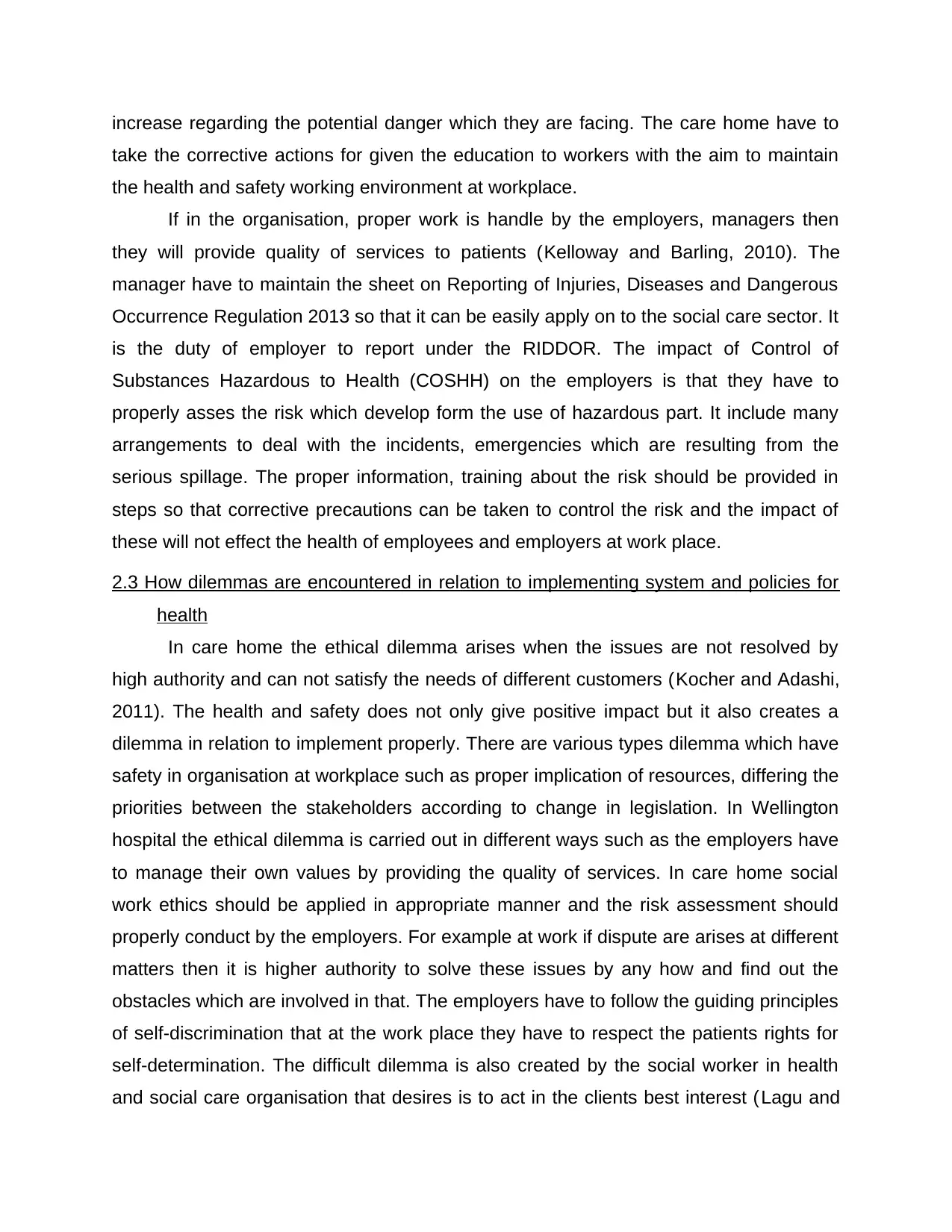
increase regarding the potential danger which they are facing. The care home have to
take the corrective actions for given the education to workers with the aim to maintain
the health and safety working environment at workplace.
If in the organisation, proper work is handle by the employers, managers then
they will provide quality of services to patients (Kelloway and Barling, 2010). The
manager have to maintain the sheet on Reporting of Injuries, Diseases and Dangerous
Occurrence Regulation 2013 so that it can be easily apply on to the social care sector. It
is the duty of employer to report under the RIDDOR. The impact of Control of
Substances Hazardous to Health (COSHH) on the employers is that they have to
properly asses the risk which develop form the use of hazardous part. It include many
arrangements to deal with the incidents, emergencies which are resulting from the
serious spillage. The proper information, training about the risk should be provided in
steps so that corrective precautions can be taken to control the risk and the impact of
these will not effect the health of employees and employers at work place.
2.3 How dilemmas are encountered in relation to implementing system and policies for
health
In care home the ethical dilemma arises when the issues are not resolved by
high authority and can not satisfy the needs of different customers (Kocher and Adashi,
2011). The health and safety does not only give positive impact but it also creates a
dilemma in relation to implement properly. There are various types dilemma which have
safety in organisation at workplace such as proper implication of resources, differing the
priorities between the stakeholders according to change in legislation. In Wellington
hospital the ethical dilemma is carried out in different ways such as the employers have
to manage their own values by providing the quality of services. In care home social
work ethics should be applied in appropriate manner and the risk assessment should
properly conduct by the employers. For example at work if dispute are arises at different
matters then it is higher authority to solve these issues by any how and find out the
obstacles which are involved in that. The employers have to follow the guiding principles
of self-discrimination that at the work place they have to respect the patients rights for
self-determination. The difficult dilemma is also created by the social worker in health
and social care organisation that desires is to act in the clients best interest (Lagu and
take the corrective actions for given the education to workers with the aim to maintain
the health and safety working environment at workplace.
If in the organisation, proper work is handle by the employers, managers then
they will provide quality of services to patients (Kelloway and Barling, 2010). The
manager have to maintain the sheet on Reporting of Injuries, Diseases and Dangerous
Occurrence Regulation 2013 so that it can be easily apply on to the social care sector. It
is the duty of employer to report under the RIDDOR. The impact of Control of
Substances Hazardous to Health (COSHH) on the employers is that they have to
properly asses the risk which develop form the use of hazardous part. It include many
arrangements to deal with the incidents, emergencies which are resulting from the
serious spillage. The proper information, training about the risk should be provided in
steps so that corrective precautions can be taken to control the risk and the impact of
these will not effect the health of employees and employers at work place.
2.3 How dilemmas are encountered in relation to implementing system and policies for
health
In care home the ethical dilemma arises when the issues are not resolved by
high authority and can not satisfy the needs of different customers (Kocher and Adashi,
2011). The health and safety does not only give positive impact but it also creates a
dilemma in relation to implement properly. There are various types dilemma which have
safety in organisation at workplace such as proper implication of resources, differing the
priorities between the stakeholders according to change in legislation. In Wellington
hospital the ethical dilemma is carried out in different ways such as the employers have
to manage their own values by providing the quality of services. In care home social
work ethics should be applied in appropriate manner and the risk assessment should
properly conduct by the employers. For example at work if dispute are arises at different
matters then it is higher authority to solve these issues by any how and find out the
obstacles which are involved in that. The employers have to follow the guiding principles
of self-discrimination that at the work place they have to respect the patients rights for
self-determination. The difficult dilemma is also created by the social worker in health
and social care organisation that desires is to act in the clients best interest (Lagu and
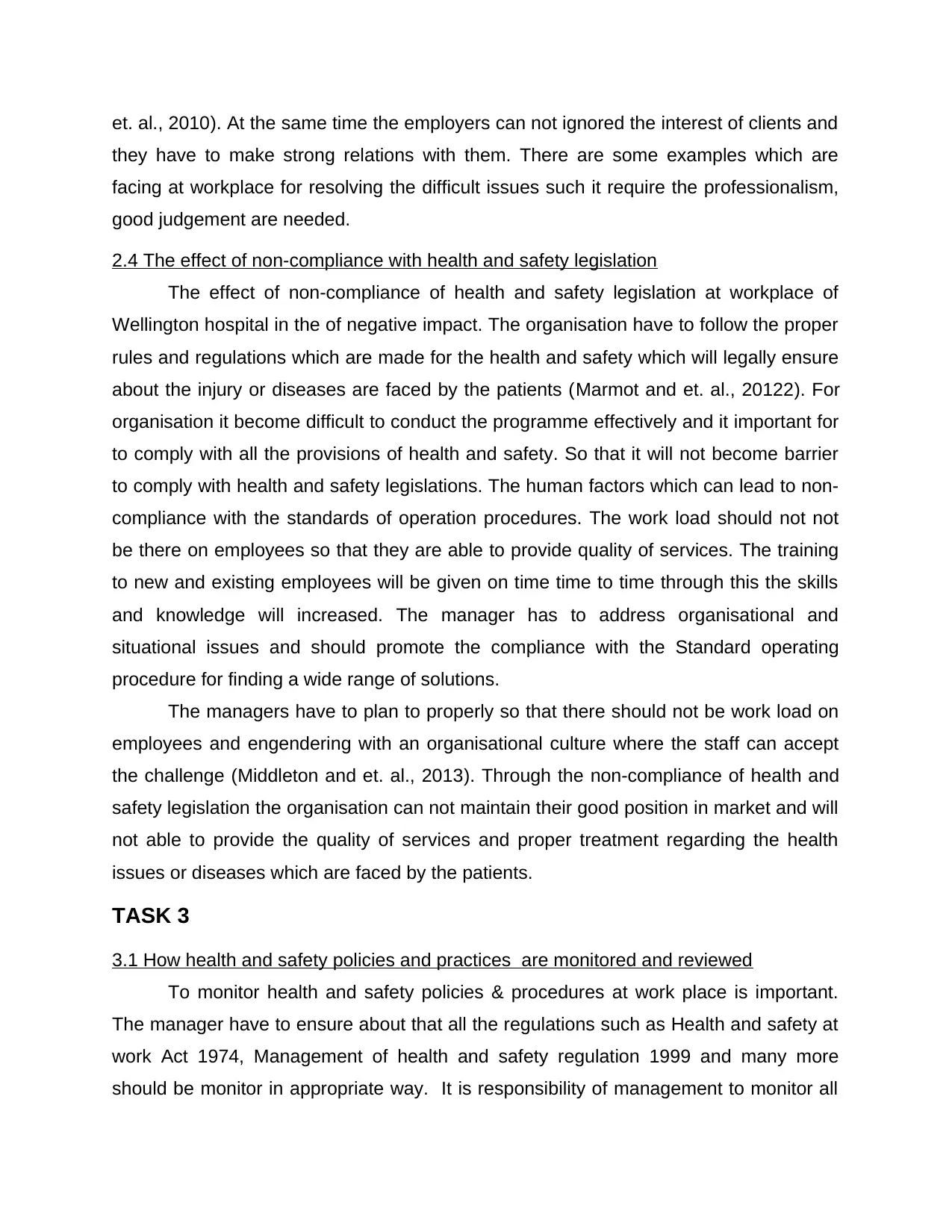
et. al., 2010). At the same time the employers can not ignored the interest of clients and
they have to make strong relations with them. There are some examples which are
facing at workplace for resolving the difficult issues such it require the professionalism,
good judgement are needed.
2.4 The effect of non-compliance with health and safety legislation
The effect of non-compliance of health and safety legislation at workplace of
Wellington hospital in the of negative impact. The organisation have to follow the proper
rules and regulations which are made for the health and safety which will legally ensure
about the injury or diseases are faced by the patients (Marmot and et. al., 20122). For
organisation it become difficult to conduct the programme effectively and it important for
to comply with all the provisions of health and safety. So that it will not become barrier
to comply with health and safety legislations. The human factors which can lead to non-
compliance with the standards of operation procedures. The work load should not not
be there on employees so that they are able to provide quality of services. The training
to new and existing employees will be given on time time to time through this the skills
and knowledge will increased. The manager has to address organisational and
situational issues and should promote the compliance with the Standard operating
procedure for finding a wide range of solutions.
The managers have to plan to properly so that there should not be work load on
employees and engendering with an organisational culture where the staff can accept
the challenge (Middleton and et. al., 2013). Through the non-compliance of health and
safety legislation the organisation can not maintain their good position in market and will
not able to provide the quality of services and proper treatment regarding the health
issues or diseases which are faced by the patients.
TASK 3
3.1 How health and safety policies and practices are monitored and reviewed
To monitor health and safety policies & procedures at work place is important.
The manager have to ensure about that all the regulations such as Health and safety at
work Act 1974, Management of health and safety regulation 1999 and many more
should be monitor in appropriate way. It is responsibility of management to monitor all
they have to make strong relations with them. There are some examples which are
facing at workplace for resolving the difficult issues such it require the professionalism,
good judgement are needed.
2.4 The effect of non-compliance with health and safety legislation
The effect of non-compliance of health and safety legislation at workplace of
Wellington hospital in the of negative impact. The organisation have to follow the proper
rules and regulations which are made for the health and safety which will legally ensure
about the injury or diseases are faced by the patients (Marmot and et. al., 20122). For
organisation it become difficult to conduct the programme effectively and it important for
to comply with all the provisions of health and safety. So that it will not become barrier
to comply with health and safety legislations. The human factors which can lead to non-
compliance with the standards of operation procedures. The work load should not not
be there on employees so that they are able to provide quality of services. The training
to new and existing employees will be given on time time to time through this the skills
and knowledge will increased. The manager has to address organisational and
situational issues and should promote the compliance with the Standard operating
procedure for finding a wide range of solutions.
The managers have to plan to properly so that there should not be work load on
employees and engendering with an organisational culture where the staff can accept
the challenge (Middleton and et. al., 2013). Through the non-compliance of health and
safety legislation the organisation can not maintain their good position in market and will
not able to provide the quality of services and proper treatment regarding the health
issues or diseases which are faced by the patients.
TASK 3
3.1 How health and safety policies and practices are monitored and reviewed
To monitor health and safety policies & procedures at work place is important.
The manager have to ensure about that all the regulations such as Health and safety at
work Act 1974, Management of health and safety regulation 1999 and many more
should be monitor in appropriate way. It is responsibility of management to monitor all
Secure Best Marks with AI Grader
Need help grading? Try our AI Grader for instant feedback on your assignments.
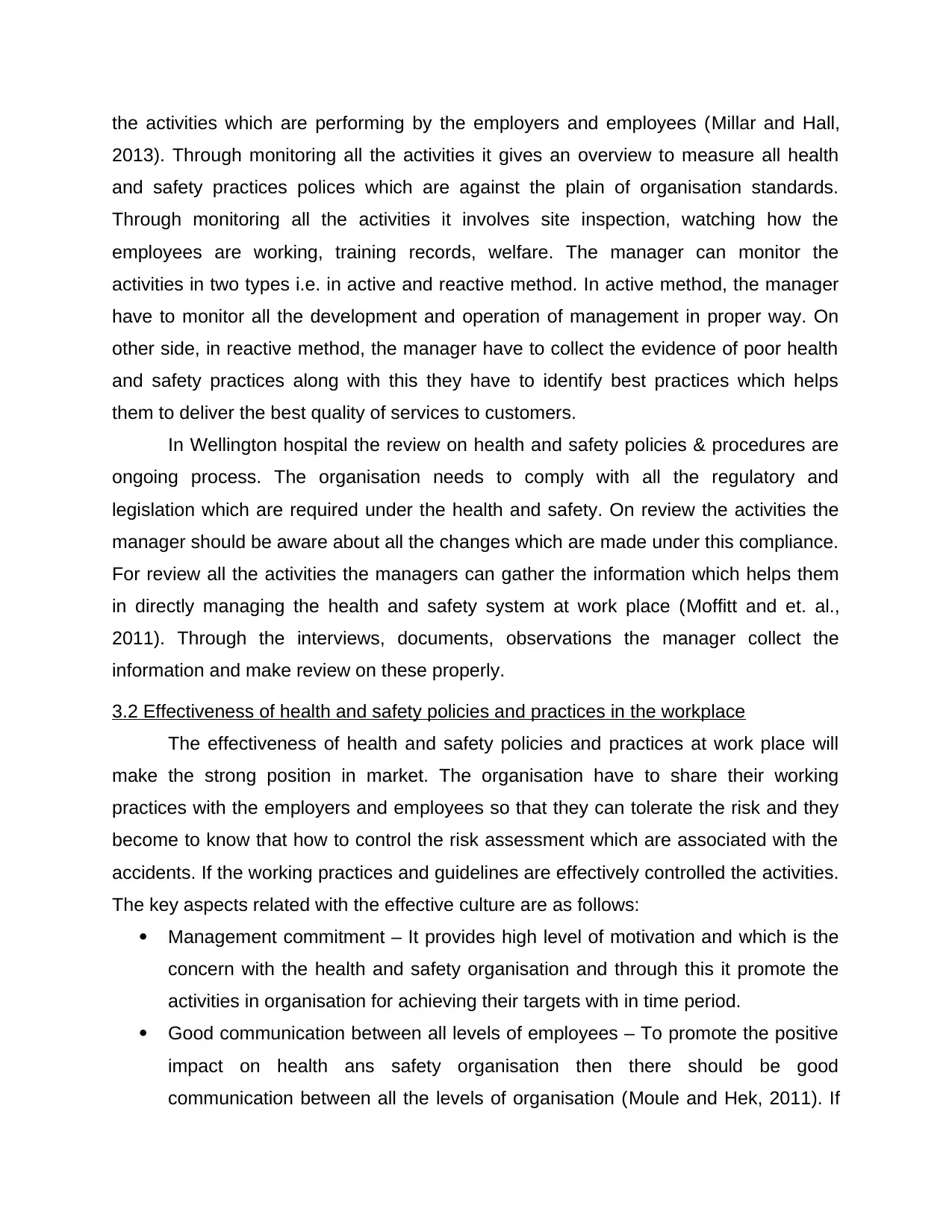
the activities which are performing by the employers and employees (Millar and Hall,
2013). Through monitoring all the activities it gives an overview to measure all health
and safety practices polices which are against the plain of organisation standards.
Through monitoring all the activities it involves site inspection, watching how the
employees are working, training records, welfare. The manager can monitor the
activities in two types i.e. in active and reactive method. In active method, the manager
have to monitor all the development and operation of management in proper way. On
other side, in reactive method, the manager have to collect the evidence of poor health
and safety practices along with this they have to identify best practices which helps
them to deliver the best quality of services to customers.
In Wellington hospital the review on health and safety policies & procedures are
ongoing process. The organisation needs to comply with all the regulatory and
legislation which are required under the health and safety. On review the activities the
manager should be aware about all the changes which are made under this compliance.
For review all the activities the managers can gather the information which helps them
in directly managing the health and safety system at work place (Moffitt and et. al.,
2011). Through the interviews, documents, observations the manager collect the
information and make review on these properly.
3.2 Effectiveness of health and safety policies and practices in the workplace
The effectiveness of health and safety policies and practices at work place will
make the strong position in market. The organisation have to share their working
practices with the employers and employees so that they can tolerate the risk and they
become to know that how to control the risk assessment which are associated with the
accidents. If the working practices and guidelines are effectively controlled the activities.
The key aspects related with the effective culture are as follows:
Management commitment – It provides high level of motivation and which is the
concern with the health and safety organisation and through this it promote the
activities in organisation for achieving their targets with in time period.
Good communication between all levels of employees – To promote the positive
impact on health ans safety organisation then there should be good
communication between all the levels of organisation (Moule and Hek, 2011). If
2013). Through monitoring all the activities it gives an overview to measure all health
and safety practices polices which are against the plain of organisation standards.
Through monitoring all the activities it involves site inspection, watching how the
employees are working, training records, welfare. The manager can monitor the
activities in two types i.e. in active and reactive method. In active method, the manager
have to monitor all the development and operation of management in proper way. On
other side, in reactive method, the manager have to collect the evidence of poor health
and safety practices along with this they have to identify best practices which helps
them to deliver the best quality of services to customers.
In Wellington hospital the review on health and safety policies & procedures are
ongoing process. The organisation needs to comply with all the regulatory and
legislation which are required under the health and safety. On review the activities the
manager should be aware about all the changes which are made under this compliance.
For review all the activities the managers can gather the information which helps them
in directly managing the health and safety system at work place (Moffitt and et. al.,
2011). Through the interviews, documents, observations the manager collect the
information and make review on these properly.
3.2 Effectiveness of health and safety policies and practices in the workplace
The effectiveness of health and safety policies and practices at work place will
make the strong position in market. The organisation have to share their working
practices with the employers and employees so that they can tolerate the risk and they
become to know that how to control the risk assessment which are associated with the
accidents. If the working practices and guidelines are effectively controlled the activities.
The key aspects related with the effective culture are as follows:
Management commitment – It provides high level of motivation and which is the
concern with the health and safety organisation and through this it promote the
activities in organisation for achieving their targets with in time period.
Good communication between all levels of employees – To promote the positive
impact on health ans safety organisation then there should be good
communication between all the levels of organisation (Moule and Hek, 2011). If
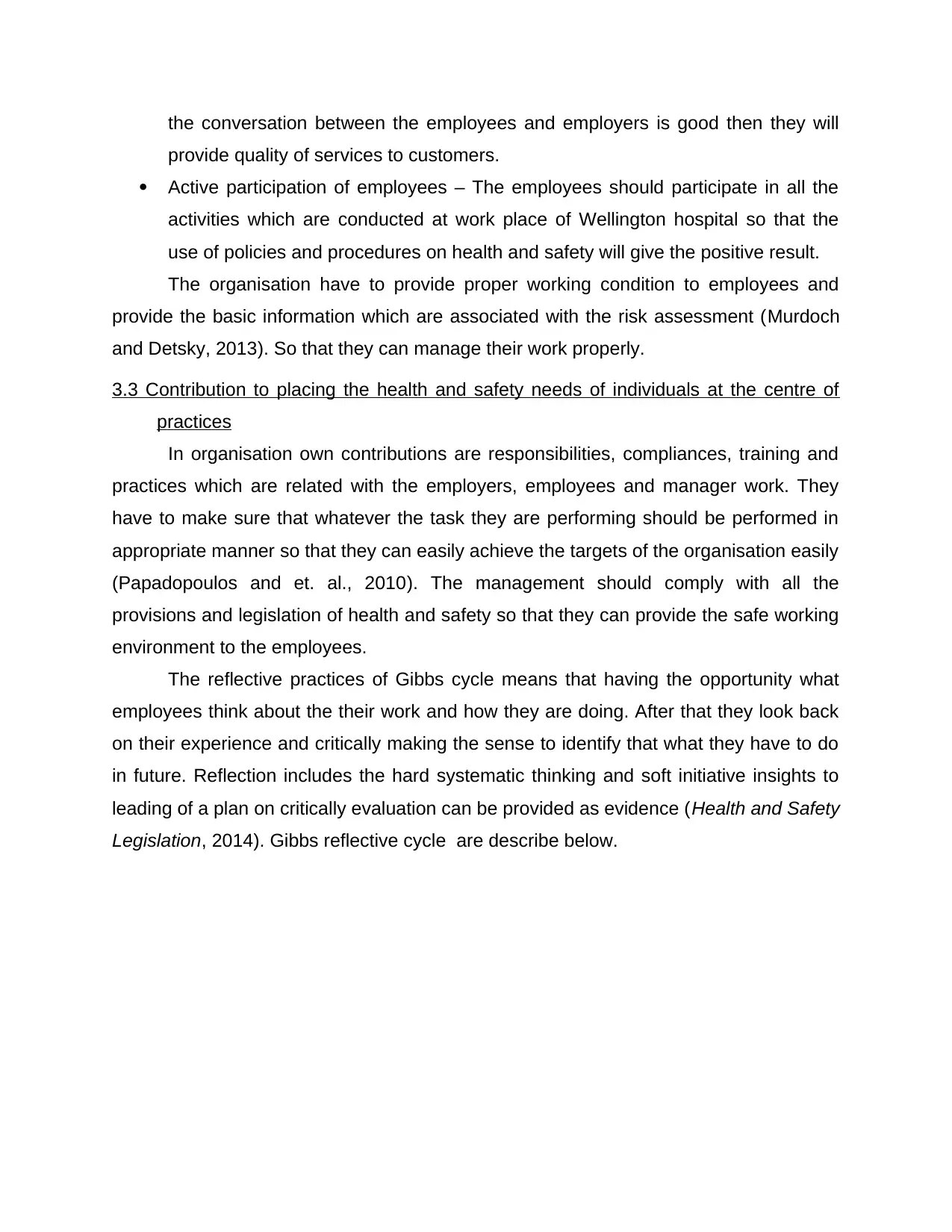
the conversation between the employees and employers is good then they will
provide quality of services to customers.
Active participation of employees – The employees should participate in all the
activities which are conducted at work place of Wellington hospital so that the
use of policies and procedures on health and safety will give the positive result.
The organisation have to provide proper working condition to employees and
provide the basic information which are associated with the risk assessment (Murdoch
and Detsky, 2013). So that they can manage their work properly.
3.3 Contribution to placing the health and safety needs of individuals at the centre of
practices
In organisation own contributions are responsibilities, compliances, training and
practices which are related with the employers, employees and manager work. They
have to make sure that whatever the task they are performing should be performed in
appropriate manner so that they can easily achieve the targets of the organisation easily
(Papadopoulos and et. al., 2010). The management should comply with all the
provisions and legislation of health and safety so that they can provide the safe working
environment to the employees.
The reflective practices of Gibbs cycle means that having the opportunity what
employees think about the their work and how they are doing. After that they look back
on their experience and critically making the sense to identify that what they have to do
in future. Reflection includes the hard systematic thinking and soft initiative insights to
leading of a plan on critically evaluation can be provided as evidence (Health and Safety
Legislation, 2014). Gibbs reflective cycle are describe below.
provide quality of services to customers.
Active participation of employees – The employees should participate in all the
activities which are conducted at work place of Wellington hospital so that the
use of policies and procedures on health and safety will give the positive result.
The organisation have to provide proper working condition to employees and
provide the basic information which are associated with the risk assessment (Murdoch
and Detsky, 2013). So that they can manage their work properly.
3.3 Contribution to placing the health and safety needs of individuals at the centre of
practices
In organisation own contributions are responsibilities, compliances, training and
practices which are related with the employers, employees and manager work. They
have to make sure that whatever the task they are performing should be performed in
appropriate manner so that they can easily achieve the targets of the organisation easily
(Papadopoulos and et. al., 2010). The management should comply with all the
provisions and legislation of health and safety so that they can provide the safe working
environment to the employees.
The reflective practices of Gibbs cycle means that having the opportunity what
employees think about the their work and how they are doing. After that they look back
on their experience and critically making the sense to identify that what they have to do
in future. Reflection includes the hard systematic thinking and soft initiative insights to
leading of a plan on critically evaluation can be provided as evidence (Health and Safety
Legislation, 2014). Gibbs reflective cycle are describe below.
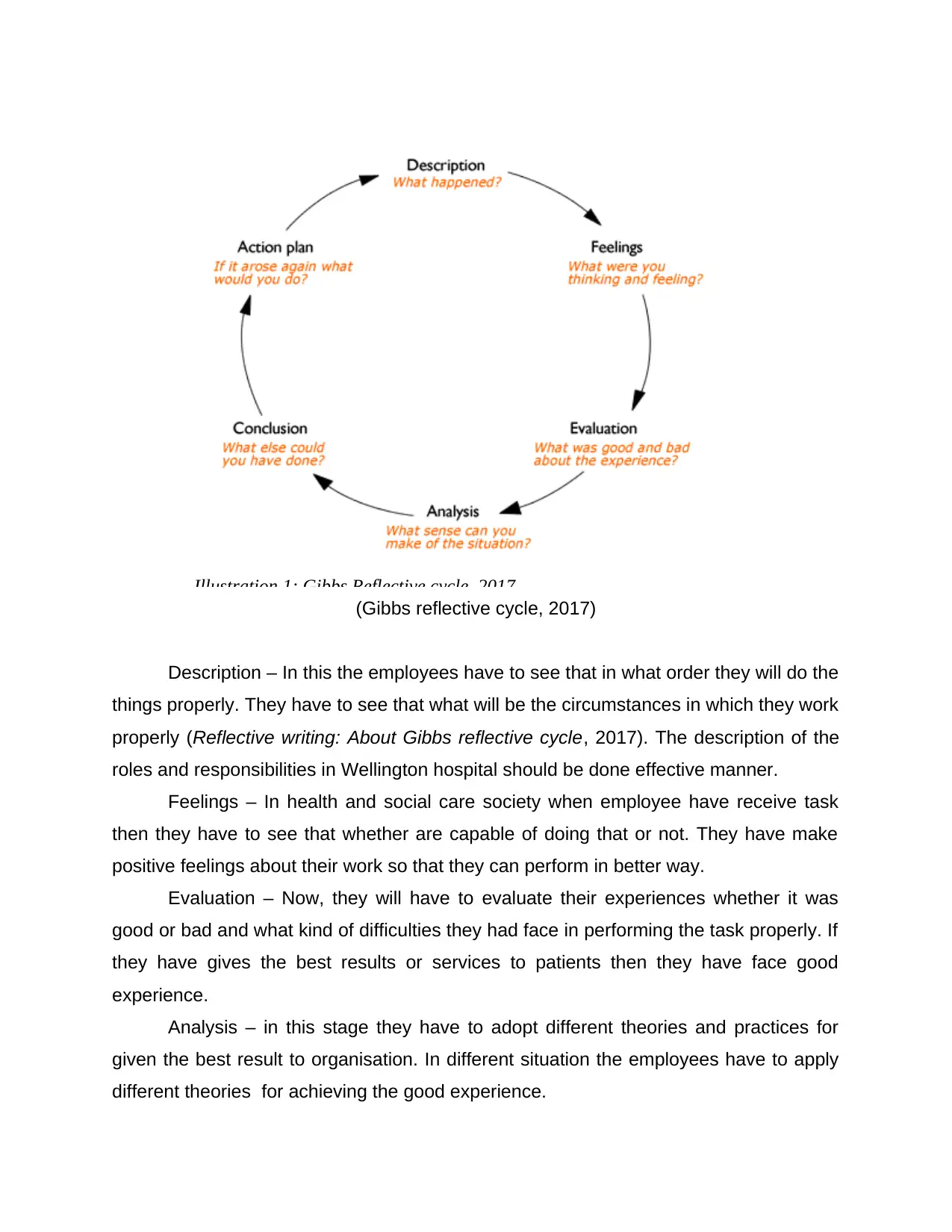
(Gibbs reflective cycle, 2017)
Description – In this the employees have to see that in what order they will do the
things properly. They have to see that what will be the circumstances in which they work
properly (Reflective writing: About Gibbs reflective cycle, 2017). The description of the
roles and responsibilities in Wellington hospital should be done effective manner.
Feelings – In health and social care society when employee have receive task
then they have to see that whether are capable of doing that or not. They have make
positive feelings about their work so that they can perform in better way.
Evaluation – Now, they will have to evaluate their experiences whether it was
good or bad and what kind of difficulties they had face in performing the task properly. If
they have gives the best results or services to patients then they have face good
experience.
Analysis – in this stage they have to adopt different theories and practices for
given the best result to organisation. In different situation the employees have to apply
different theories for achieving the good experience.
Illustration 1: Gibbs Reflective cycle, 2017
Description – In this the employees have to see that in what order they will do the
things properly. They have to see that what will be the circumstances in which they work
properly (Reflective writing: About Gibbs reflective cycle, 2017). The description of the
roles and responsibilities in Wellington hospital should be done effective manner.
Feelings – In health and social care society when employee have receive task
then they have to see that whether are capable of doing that or not. They have make
positive feelings about their work so that they can perform in better way.
Evaluation – Now, they will have to evaluate their experiences whether it was
good or bad and what kind of difficulties they had face in performing the task properly. If
they have gives the best results or services to patients then they have face good
experience.
Analysis – in this stage they have to adopt different theories and practices for
given the best result to organisation. In different situation the employees have to apply
different theories for achieving the good experience.
Illustration 1: Gibbs Reflective cycle, 2017
Paraphrase This Document
Need a fresh take? Get an instant paraphrase of this document with our AI Paraphraser
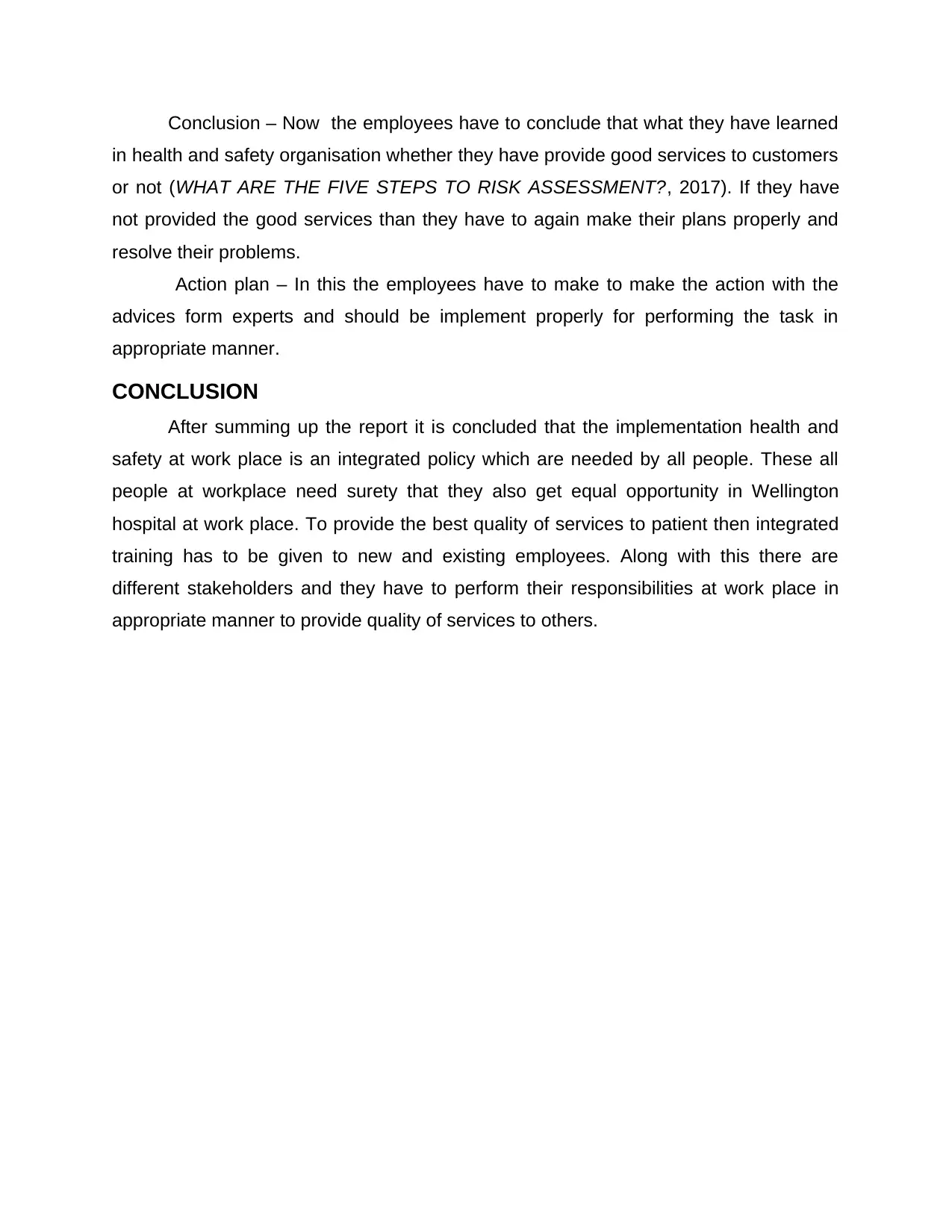
Conclusion – Now the employees have to conclude that what they have learned
in health and safety organisation whether they have provide good services to customers
or not (WHAT ARE THE FIVE STEPS TO RISK ASSESSMENT?, 2017). If they have
not provided the good services than they have to again make their plans properly and
resolve their problems.
Action plan – In this the employees have to make to make the action with the
advices form experts and should be implement properly for performing the task in
appropriate manner.
CONCLUSION
After summing up the report it is concluded that the implementation health and
safety at work place is an integrated policy which are needed by all people. These all
people at workplace need surety that they also get equal opportunity in Wellington
hospital at work place. To provide the best quality of services to patient then integrated
training has to be given to new and existing employees. Along with this there are
different stakeholders and they have to perform their responsibilities at work place in
appropriate manner to provide quality of services to others.
in health and safety organisation whether they have provide good services to customers
or not (WHAT ARE THE FIVE STEPS TO RISK ASSESSMENT?, 2017). If they have
not provided the good services than they have to again make their plans properly and
resolve their problems.
Action plan – In this the employees have to make to make the action with the
advices form experts and should be implement properly for performing the task in
appropriate manner.
CONCLUSION
After summing up the report it is concluded that the implementation health and
safety at work place is an integrated policy which are needed by all people. These all
people at workplace need surety that they also get equal opportunity in Wellington
hospital at work place. To provide the best quality of services to patient then integrated
training has to be given to new and existing employees. Along with this there are
different stakeholders and they have to perform their responsibilities at work place in
appropriate manner to provide quality of services to others.
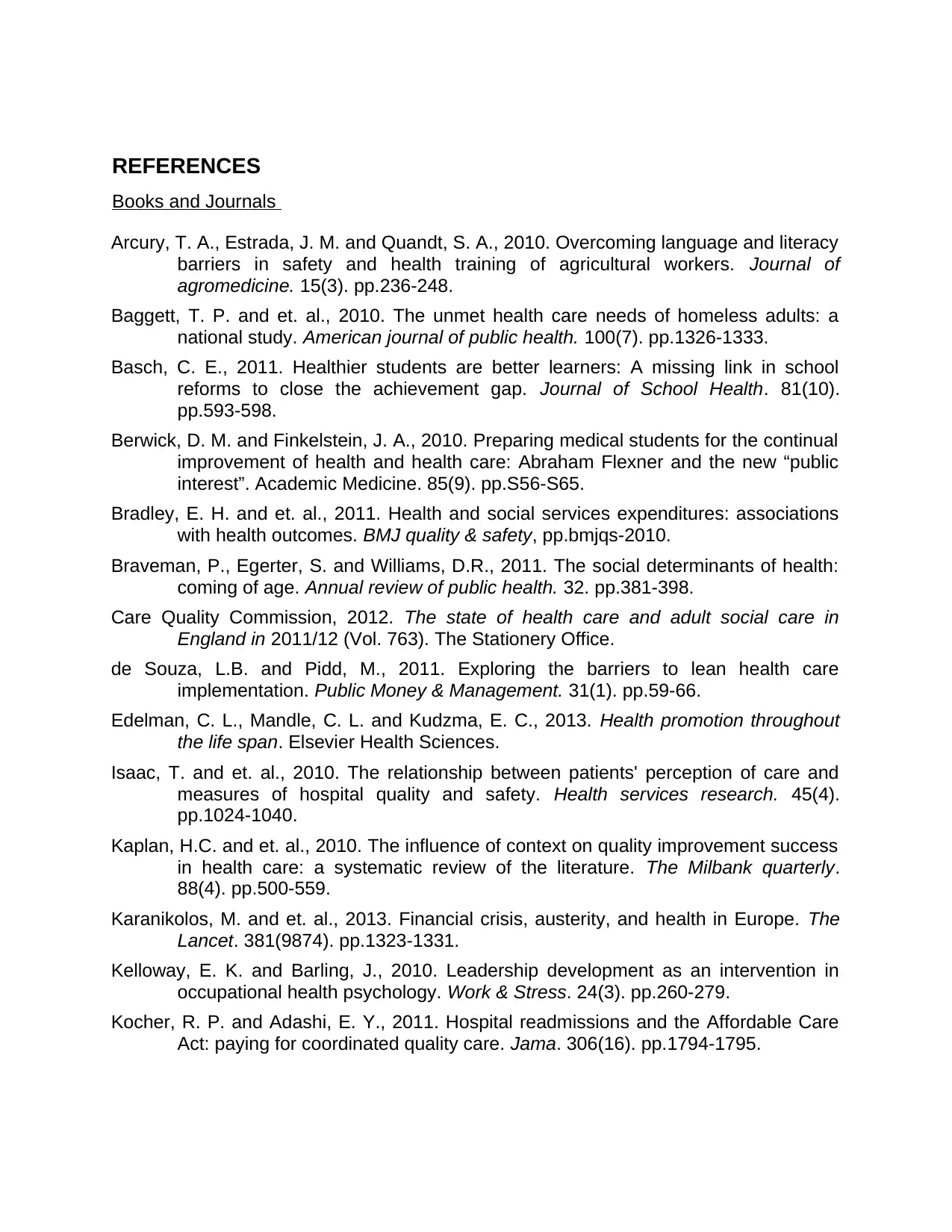
REFERENCES
Books and Journals
Arcury, T. A., Estrada, J. M. and Quandt, S. A., 2010. Overcoming language and literacy
barriers in safety and health training of agricultural workers. Journal of
agromedicine. 15(3). pp.236-248.
Baggett, T. P. and et. al., 2010. The unmet health care needs of homeless adults: a
national study. American journal of public health. 100(7). pp.1326-1333.
Basch, C. E., 2011. Healthier students are better learners: A missing link in school
reforms to close the achievement gap. Journal of School Health. 81(10).
pp.593-598.
Berwick, D. M. and Finkelstein, J. A., 2010. Preparing medical students for the continual
improvement of health and health care: Abraham Flexner and the new “public
interest”. Academic Medicine. 85(9). pp.S56-S65.
Bradley, E. H. and et. al., 2011. Health and social services expenditures: associations
with health outcomes. BMJ quality & safety, pp.bmjqs-2010.
Braveman, P., Egerter, S. and Williams, D.R., 2011. The social determinants of health:
coming of age. Annual review of public health. 32. pp.381-398.
Care Quality Commission, 2012. The state of health care and adult social care in
England in 2011/12 (Vol. 763). The Stationery Office.
de Souza, L.B. and Pidd, M., 2011. Exploring the barriers to lean health care
implementation. Public Money & Management. 31(1). pp.59-66.
Edelman, C. L., Mandle, C. L. and Kudzma, E. C., 2013. Health promotion throughout
the life span. Elsevier Health Sciences.
Isaac, T. and et. al., 2010. The relationship between patients' perception of care and
measures of hospital quality and safety. Health services research. 45(4).
pp.1024-1040.
Kaplan, H.C. and et. al., 2010. The influence of context on quality improvement success
in health care: a systematic review of the literature. The Milbank quarterly.
88(4). pp.500-559.
Karanikolos, M. and et. al., 2013. Financial crisis, austerity, and health in Europe. The
Lancet. 381(9874). pp.1323-1331.
Kelloway, E. K. and Barling, J., 2010. Leadership development as an intervention in
occupational health psychology. Work & Stress. 24(3). pp.260-279.
Kocher, R. P. and Adashi, E. Y., 2011. Hospital readmissions and the Affordable Care
Act: paying for coordinated quality care. Jama. 306(16). pp.1794-1795.
Books and Journals
Arcury, T. A., Estrada, J. M. and Quandt, S. A., 2010. Overcoming language and literacy
barriers in safety and health training of agricultural workers. Journal of
agromedicine. 15(3). pp.236-248.
Baggett, T. P. and et. al., 2010. The unmet health care needs of homeless adults: a
national study. American journal of public health. 100(7). pp.1326-1333.
Basch, C. E., 2011. Healthier students are better learners: A missing link in school
reforms to close the achievement gap. Journal of School Health. 81(10).
pp.593-598.
Berwick, D. M. and Finkelstein, J. A., 2010. Preparing medical students for the continual
improvement of health and health care: Abraham Flexner and the new “public
interest”. Academic Medicine. 85(9). pp.S56-S65.
Bradley, E. H. and et. al., 2011. Health and social services expenditures: associations
with health outcomes. BMJ quality & safety, pp.bmjqs-2010.
Braveman, P., Egerter, S. and Williams, D.R., 2011. The social determinants of health:
coming of age. Annual review of public health. 32. pp.381-398.
Care Quality Commission, 2012. The state of health care and adult social care in
England in 2011/12 (Vol. 763). The Stationery Office.
de Souza, L.B. and Pidd, M., 2011. Exploring the barriers to lean health care
implementation. Public Money & Management. 31(1). pp.59-66.
Edelman, C. L., Mandle, C. L. and Kudzma, E. C., 2013. Health promotion throughout
the life span. Elsevier Health Sciences.
Isaac, T. and et. al., 2010. The relationship between patients' perception of care and
measures of hospital quality and safety. Health services research. 45(4).
pp.1024-1040.
Kaplan, H.C. and et. al., 2010. The influence of context on quality improvement success
in health care: a systematic review of the literature. The Milbank quarterly.
88(4). pp.500-559.
Karanikolos, M. and et. al., 2013. Financial crisis, austerity, and health in Europe. The
Lancet. 381(9874). pp.1323-1331.
Kelloway, E. K. and Barling, J., 2010. Leadership development as an intervention in
occupational health psychology. Work & Stress. 24(3). pp.260-279.
Kocher, R. P. and Adashi, E. Y., 2011. Hospital readmissions and the Affordable Care
Act: paying for coordinated quality care. Jama. 306(16). pp.1794-1795.
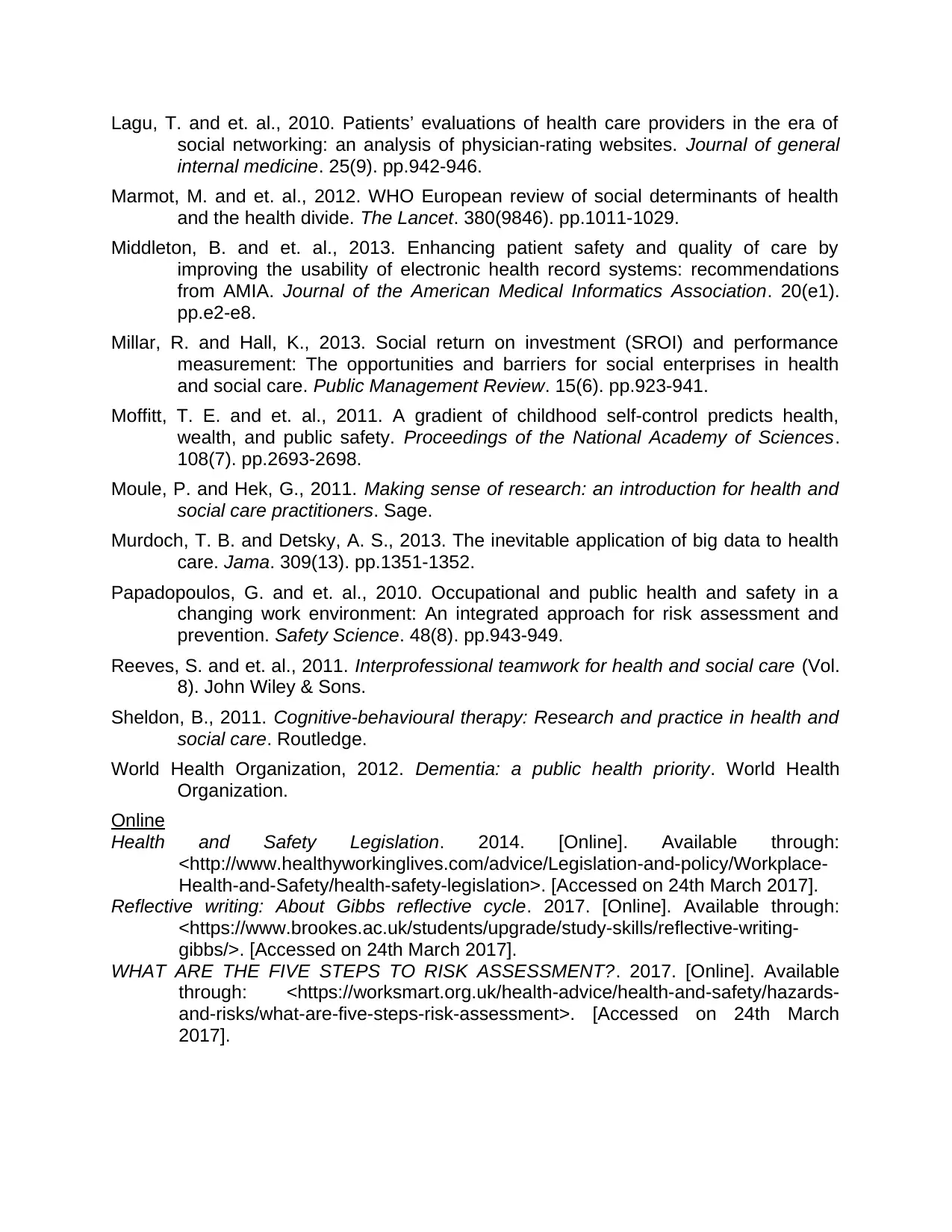
Lagu, T. and et. al., 2010. Patients’ evaluations of health care providers in the era of
social networking: an analysis of physician-rating websites. Journal of general
internal medicine. 25(9). pp.942-946.
Marmot, M. and et. al., 2012. WHO European review of social determinants of health
and the health divide. The Lancet. 380(9846). pp.1011-1029.
Middleton, B. and et. al., 2013. Enhancing patient safety and quality of care by
improving the usability of electronic health record systems: recommendations
from AMIA. Journal of the American Medical Informatics Association. 20(e1).
pp.e2-e8.
Millar, R. and Hall, K., 2013. Social return on investment (SROI) and performance
measurement: The opportunities and barriers for social enterprises in health
and social care. Public Management Review. 15(6). pp.923-941.
Moffitt, T. E. and et. al., 2011. A gradient of childhood self-control predicts health,
wealth, and public safety. Proceedings of the National Academy of Sciences.
108(7). pp.2693-2698.
Moule, P. and Hek, G., 2011. Making sense of research: an introduction for health and
social care practitioners. Sage.
Murdoch, T. B. and Detsky, A. S., 2013. The inevitable application of big data to health
care. Jama. 309(13). pp.1351-1352.
Papadopoulos, G. and et. al., 2010. Occupational and public health and safety in a
changing work environment: An integrated approach for risk assessment and
prevention. Safety Science. 48(8). pp.943-949.
Reeves, S. and et. al., 2011. Interprofessional teamwork for health and social care (Vol.
8). John Wiley & Sons.
Sheldon, B., 2011. Cognitive-behavioural therapy: Research and practice in health and
social care. Routledge.
World Health Organization, 2012. Dementia: a public health priority. World Health
Organization.
Online
Health and Safety Legislation. 2014. [Online]. Available through:
<http://www.healthyworkinglives.com/advice/Legislation-and-policy/Workplace-
Health-and-Safety/health-safety-legislation>. [Accessed on 24th March 2017].
Reflective writing: About Gibbs reflective cycle. 2017. [Online]. Available through:
<https://www.brookes.ac.uk/students/upgrade/study-skills/reflective-writing-
gibbs/>. [Accessed on 24th March 2017].
WHAT ARE THE FIVE STEPS TO RISK ASSESSMENT?. 2017. [Online]. Available
through: <https://worksmart.org.uk/health-advice/health-and-safety/hazards-
and-risks/what-are-five-steps-risk-assessment>. [Accessed on 24th March
2017].
social networking: an analysis of physician-rating websites. Journal of general
internal medicine. 25(9). pp.942-946.
Marmot, M. and et. al., 2012. WHO European review of social determinants of health
and the health divide. The Lancet. 380(9846). pp.1011-1029.
Middleton, B. and et. al., 2013. Enhancing patient safety and quality of care by
improving the usability of electronic health record systems: recommendations
from AMIA. Journal of the American Medical Informatics Association. 20(e1).
pp.e2-e8.
Millar, R. and Hall, K., 2013. Social return on investment (SROI) and performance
measurement: The opportunities and barriers for social enterprises in health
and social care. Public Management Review. 15(6). pp.923-941.
Moffitt, T. E. and et. al., 2011. A gradient of childhood self-control predicts health,
wealth, and public safety. Proceedings of the National Academy of Sciences.
108(7). pp.2693-2698.
Moule, P. and Hek, G., 2011. Making sense of research: an introduction for health and
social care practitioners. Sage.
Murdoch, T. B. and Detsky, A. S., 2013. The inevitable application of big data to health
care. Jama. 309(13). pp.1351-1352.
Papadopoulos, G. and et. al., 2010. Occupational and public health and safety in a
changing work environment: An integrated approach for risk assessment and
prevention. Safety Science. 48(8). pp.943-949.
Reeves, S. and et. al., 2011. Interprofessional teamwork for health and social care (Vol.
8). John Wiley & Sons.
Sheldon, B., 2011. Cognitive-behavioural therapy: Research and practice in health and
social care. Routledge.
World Health Organization, 2012. Dementia: a public health priority. World Health
Organization.
Online
Health and Safety Legislation. 2014. [Online]. Available through:
<http://www.healthyworkinglives.com/advice/Legislation-and-policy/Workplace-
Health-and-Safety/health-safety-legislation>. [Accessed on 24th March 2017].
Reflective writing: About Gibbs reflective cycle. 2017. [Online]. Available through:
<https://www.brookes.ac.uk/students/upgrade/study-skills/reflective-writing-
gibbs/>. [Accessed on 24th March 2017].
WHAT ARE THE FIVE STEPS TO RISK ASSESSMENT?. 2017. [Online]. Available
through: <https://worksmart.org.uk/health-advice/health-and-safety/hazards-
and-risks/what-are-five-steps-risk-assessment>. [Accessed on 24th March
2017].
1 out of 16
Related Documents
Your All-in-One AI-Powered Toolkit for Academic Success.
+13062052269
info@desklib.com
Available 24*7 on WhatsApp / Email
![[object Object]](/_next/static/media/star-bottom.7253800d.svg)
Unlock your academic potential
© 2024 | Zucol Services PVT LTD | All rights reserved.





